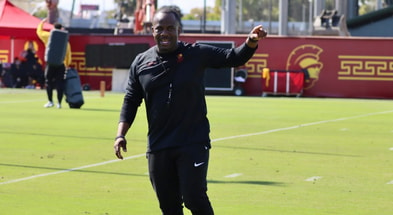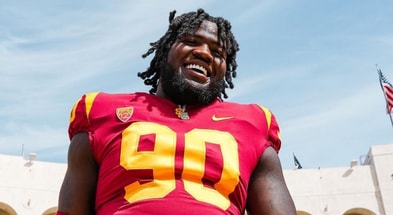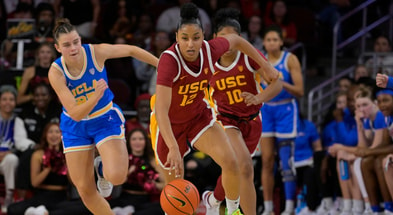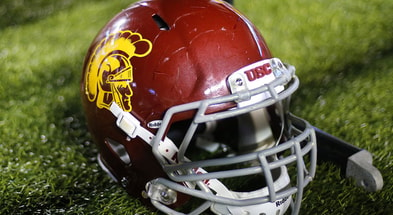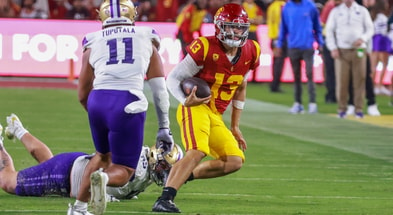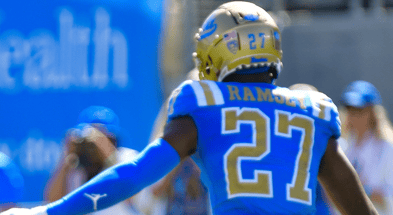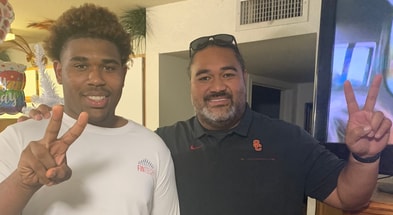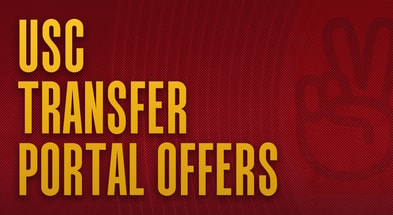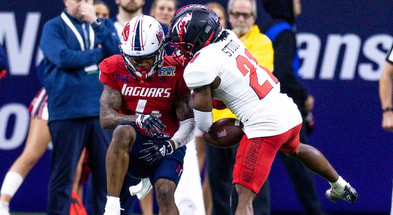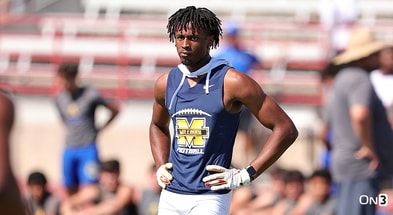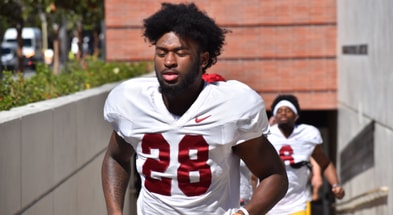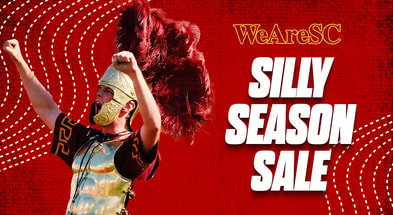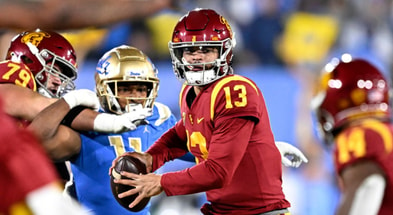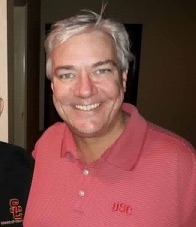Q&A with USC Head S&C Coach Aaron Ausmus
The USC Trojans hired Aaron Ausmus as their head strength and conditioning coach this past March, making this the third stint at USC for Ausmus. He was an assistant coach from 2001-2003, and then named the head strength coach in 2010 before being replaced when Steve Sarkisian took over as head coach in 2013.
In an extensive question and answer session, Ausmus spoke about his philosophy, preparing the Trojans for the 2019 season, and being back at USC.
Q: What is it like being back at USC?
“Kind of just crazy. I packed this office in December of 2013 when coach Sark came in and brought a replacement, and then to come back and get back in here, you really would never expect that to be a true story. It’s like some fictional novel. But it really happened. For me, it was a great blessing, great opportunity. I stayed put right here in Redondo Beach. My kids had been here for a while and I was putting their interest at the highest level for me. I was doing some other things, kind of on the strength side more, consulting and sales and different equipment and stuff, which allowed me to go around the country, especially in the western region of the United States—do a lot of visits with a lot of coaches and help them maybe build their dream facilities like we built this one in 2012. It allowed me to really stay in the profession, just in a little bit of a different way. And then this opportunity to come back to a familiar place for the third time was, again, you really couldn’t write that in a script.”
Q: How did the contact with USC begin?
“He called me. We’ve been longtime co-workers and I’ve stayed in touch with him, I would say, not really good over the time he was here, but he stayed a contact in my phone and when he did hit some milestones—meaning, when he was named interim, I was wishing him the best of luck. When he got the fulltime role, congratulations. Of course, when they won the Pac-12, things like that. I think I saw him at one get together. He reached out and wanted to know if I would be interested in coming back and coaching here, and of course I said, ‘Well, again, it’s a family decision for me.’ I talked with my family and the situation, it was a no-brainer.”
Q: Did the years away from coaching allow you to evaluate anything you were doing or bring any new teachings or techniques with you?
“The last time we were here, I packed my office after winning 10 games. I didn’t feel like we were pushed out of here because we did horrible. We were pushed out because of the coaching change. I think we did some things that were pretty successful here and won some quality games in kind of some hard times, with no bowl eligibility and restriction of scholarships. It was good for me to come back and see a bigger roster than I remember working with. That’s the first thing I noticed at practice, I’m like, ‘Heck, there’s bodies. It’s not thinned out.’ The biggest thing for me was to get to hire the right staff with me. That was something I stressed with Coach in our initial talks, was, am I allowed to go find some people who I really believe in that will be loyal, who I, in those years when I went out and went to other schools and watched them train and work with athletes, those are kind of guys I put in my black book of, there’s a great coach. And I’d stay in touch with those guys over time. He gave me the green light to pick the people I wanted. I immediately reached out to them within 24 hours and they were all gung-ho to come. That was pretty much the setup for me—select the right people, and the right people want to come back. Darren [Mustin] was here in 2013. We’d just hired him that year in March. He had a short stint here—roughly nine and a half months. When reaching out to him, his first things was, ‘I’ve got unfinished business at USC.' He’d just gotten there and he felt like he had a little chip on his shoulder and he wanted to come back because he thinks it’s a great place to build a program. There’s athletes and it has a great history. Everybody was super gung-ho. They were like, ‘Absolutely. Let’s do this.’ So that was a big part.”
Q: What has the buy-in been like from the team?
“I felt like I came into a very humble team. My introductory meeting with them was really 20 minutes before I got to train them down here in the weight room. My meeting with them was like, this meeting ain’t about me and who I am. This meeting is all about you guys. I said I’m going to ask you to do two things for the rest of this year—commit to the program and compete within the program. I said, if you’ll do those two things, everything will really fall into place. So we really reiterate that daily in our program. Sometimes we blow the whistle and bring it up. What are the two things we asked you to do? They’ll say, commit and compete. We like to re-remind them of exactly what I asked them to do on the first day. So that’s all we’ve been working on. We’re really trying to really get their intent to be really high when they come in—meaning we’re going to have a really simple, strong, basic program, that’s going to be consistent in here daily. And if they’ll come in and approach it with a lot of intent and a lot of passion behind it, everything will fall into place.
“It was a humble team. We talked the other day. We’ve been going now for seven weeks and we haven’t had one player complain. We were lifting total body, between practice days of spring ball. We didn’t have one player complaining at practice that their legs were tired from the lift the day before. I think they’re all on this mission. We’re a new staff and we kind of hit the reset button in here. We feel they’ve been doing everything we’ve asked at the highest level. We talked about with our staff, no one has complained and they’re doing everything we’ve asked, which tells us their mindset of they want to erase a year ago and blaze a new path.”
Q: What are your core philosophies as a strength and conditioning coach?
“My biggest thing is, if we’re going to put an exercise in the card, or the plan as you’d call it, then we’re going to be really damn good at it. Bottom line. So if we’re going to have power clean in our program, our athletes are going to be able to power clean really well. And I’m not talking a number. I’m talking about how to perform the movement. If we’re going to have a squat, we’re going to be really technically good at those movements, because there’s a huge benefit from doing it right. So that’s been the biggest things for me, is we’re trying to do really simple really well. And the players seem like they’re really liking that we’re not throwing a whole book at them right now. We’ve really been throwing six major movements at them and they’re really trying to be masters of those six major movements, then we’ll sprinkle in some other little things around those six. But every day they come in, they know we’re going to attack either all six of those in one day, or sections of those, and be really good at.
“It’s a philosophy we built. Our four pillars. Number one is faith. We want to go out as a strength staff and have faith in the movements that we present to our players. A high school coach might say, can I have your program? No. Why? Because, what are you comfortable coaching. Well…. Now you’ve already probably told me, not a whole lot. So why would I give you our plan if you don’t know how to coach our plan. We feel, if we’re going to have faith that power cleans make us more powerful, then we better know how to coach and really critique and help them be great at power cleans. If we go out as a staff as high faith in those movements and we’re united as a strength staff, meaning we call it the same, we coach it the same, we correct it the same, then these athletes are saying, man, this staff, they’re pretty confident in what they’re telling us. This coach told me this thing this day, and four days later, this other guy told me the exact same thing in fixing my technique. They seem to be on the same page. That’s really important. If we have that kind of faith in what we do, guess what, they start having faith in us.
The next pillar is passion, which is basically to love something. As a strength staff, we go out every day and they feel our passion to be coaching. They feel that we can’t wait to work with them, so in turn, they start coming in with passion. You talk about intent. The biggest change I’ve seen in the seven weeks we’ve been here is that every day they’re in here, I can feel their passion rising a little bit more. Ours has stayed the same, but theirs is starting to match. I told them that I want their passion to beat our passion of wanting them to be great.
The third one is mentor. We talked about spreading out in the dining hall. Obviously it’s to teach. Sometimes you have to come down and you’re not so much a coach to these guys. You take your whistle off and you talk a little bit more as a friend to the player. Right now we have about a dozen guys we’re going to try to put on anywhere from five to 20 pounds over the summer. We know in here is the stimulus, but how can we get them to feed themselves? So we feel we’re really going to have to mentor these guys. We have to put our arm around them and mentor them, and as a staff, we can’t just have one guy saying hey you have to eat well tonight. We have to have everybody saying the same thing, mentoring these guys one at a time.
And the last one: integrity. I feel integrity is to uphold our standard. If our standard is being on time, then we’re going to uphold that. If our standard deals with what they’re wearing, if their shoes are tied, then that’s our job to uphold that and that supports our integrity. If we’re strong in those four, then our roof stands nice and level with our program.
“Our philosophy right now is, simple, strong, and consistent. Simple movements, do them really strong and do them really consistent.”
Q: What role does a strength and conditioning program and coach play in injury prevention?
“It’s tough. It’s a lot of good and bad luck. I’ve run a strength program before and we have a year of not a lot of injuries, and of course people will start bragging on you, and I’m like, careful. Because if you take credit for a year with low injuries, then you must take credit for a year with bad injuries. I always tell people you have to be careful with what you say. It’s a contact sport and there are going to be some injuries where, no matter what you did, a certain hit at a certain angle by a certain body part from someone else it probably going to cause an injury. Things like hamstring pulls and things like that—those are things we look at a little bit more. Did we prepare the guys well? Did they go into camp after 10 days and you have five or six guys missing practice because of hamstrings, then you’re probably going to back and go, wow, we probably missed here somehow. Or does it fall into the hydration and feeding the guys? That’s where you start analyzing the program, probably a little bit more in the soft tissue injuries. And of course, shoulders are a huge part of the game. I think the more you can build protection around that shoulder joint, which means muscle, you have a better chance of guys delivering, taking hits, falling on the ground onto shoulders. You have a little better chance to protect those. So that’s something we’re addressing with these guys now, daily, especially with our defensive backs and wide receiver, the thinner body types, trying to build that casing around the shoulder to be a little stronger.”
Q: Are there benefits to having coached previously at USC?
“Just being around great players here in the past, obviously that’s a benefit. You have examples to tell stories with. Players love to hear a great story about a great Trojan, with Troy [Polamalu] and Carson [Palmer], Shaun Cody and the great winning that took place. A lot of those guys are on the lifter of the year trophy in here because of how they competed, so I really go back to, these guys committed and competed in the program. It’s the exact same thing I’m asking you to do. That’s big, obviously, the history of the program, the Coliseum, the practice habits of being a Trojan. Those are huge benefits because I’m trying to help educate the two guys I did bring [Jared Klingenberg and Ty Webb] that have not been a part of that. And when I tell them things about what the Coliseum is like and what the expectations are like, it really gets them excited. Of course Darren was here one season, so he’s affirming that with me to those two new guys. We had Lee Webb in here yesterday and he spoke to the team 45 seconds before they lifted and he just told them, your best competition should be your teammates in practice. And that’s what we established and we were tired and sore from practice way more than we were from games, and that’s the standard you want to start holding yourselves to, and that starts here in the weight room.”
Q: How familiar were you with the roster when you arrived in March?
“I kept up and watched games, but this was a fresh roster for me. It’s a full five-year gap. Seeing a few of the marquee players from last year—the receiver who catches the ball a lot or the quarterback who throws it. These names when I first saw them, I had no clue who these guys are. And it’s a unique way to do it because right away you lean their first name or their last name—you can hardly ever learn them both—and then as time goes, I’ll hear one of my assistants call a guy by his first name where I only know his last name. He’ll say, ‘Hey Andrew.’ And I’ll say, ‘That’s Vorhees.’ And okay, we’re starting to put this together. It’s kind of neat how you start learning your roster, and it’s so funny to see these players, where their names have been known in this weight room for years, and we come in and we’re like, ‘Hey you,’ and they’re saying, holy cow, they’re talking to me like I haven’t done anything here. But I don’t know you. I’m just coaching you. For them, they’re like, whoa.”
Q: Have any players emerged quickly as far as potential weight room standouts or leaders?
“You start seeing guys right away. The eye contact, the body language. Sometimes they go out of their way to start talking to you in the hallway. Obviously those guys you start learning their names faster because they’re taking more initiative than just in here. Something we did as a strength staff with dining hall opportunities, we would spread out as a strength staff and go sit at a table with players. We’d kind of, awkwardly, chum it up with guys, because we were in a phase where we’re trying to rapidly getting to know the team. So we could have easily sat up there as five strength coaches at our own table, be as comfortable as possible, and keep gabbing it up like we do down here. But I said, hey, here’s our mission. We have to learn our team a lot faster, because we all got here in early March. So you sit with that group, you sit with that group, I’ll sit with this group. Start learning about these guys. Find out where they’re from, if they have any brothers or sisters. Start letting them know us, because the quicker we can build loyalty and trust, the harder they’ll work.
“It’s really hard to pick. If we sit down as a staff, we could pick maybe a dozen who we feel are going to be leader-type potential guys. We’re in the process of learning our team and we’re obviously going to take that dozen and try to bring them in and get them comfortable being leaders, and let them know that we have their backs throughout the summer program. Because there are always opportunities that happen in a locker room or when they’re out there on the field throwing the ball around themselves, and we can’t be there, there’s always times where players have opportunities to lead, and we’re going to try to teach them that it is time to step up, say something, lead the right way, and teach the rest of the team, when those things happen, to back the leader. He’s trying to do something good here.”
Q: How often and to what extent do head coaches influence the strength and conditioning program?
“I’ve worked with different coaches and they’re all different. Coach Helton feels he’s not the expert in this field and he wants me to be that. He’s going to rely on me. He wants a strong program, a strong team, a fast team, obviously a great conditioned team, and hopefully a team that can resist injuries as much as possible. And every head coach wants that. You’re going to have some head coaches who want to put their two cents in. A great example was Lane Kiffin. He said, I want to go over at least once a summer and I want the team to run the stadium. That’s their field, that’s the home they defend. Get them comfortable going over there. It was a fun day and it was a tough day. We’d put them on competitive teams and we’d race up certain aisled and make it a relay, and guys liked it. But that was Lane’s really only two cents of something he wanted me to do. With coach Helton, we’re only starting to set up the summer program. I don’t think we’ve gotten to the phase where if he wanted to sprinkle in a particular thing with the team, but right now he’s just, hey, I’m trusting you’re doing the right thing for the phase we’re in right now.”
Q: How much time do you get to spend with the team during the summer?
“Eight hours a week. The players can work up to eight hours a week. Two of those eight hours can be with the football coaches, which is a new rule from the last time I was here. Before, they could have no contact. If they even crossed hallways by the weight room, it was a little bit frowned upon. But now they can go out on the field, without a ball, and have some contact with the coaches. Or they can conduct a 30 minute, let’s just watch our drills from the spring and get better. So that’s pretty unique, which would limit me to six hours. And that’s usually the time I take. It’s usually four 90-minute segments a week, which is six hours. You want to have a structured, tough summer, but also you want to give them some time. The last thing you want is a really tired, beat up team to start on August 1. You want to give them Saturdays and Sundays off, so they can spend some time and be a 19-year-old kid, or see their family. So we structure it to where we’re going to work really hard, but you get to be a person too, because you should have a life.”
Q: Does the Air Raid offensive system change at all what you do in the weight room?
“It’s definitely a new one for me. Obviously with coach Harrell—and we’re going to have to pick his brain a little bit. We just got a ton of data from spring with the Catapult system, that will tell us. He has already said, the receivers especially need to be able to run quick and hard with really short rest intervals. That’s different than a pro style. Pro style, you’re eating up that play clock, you’re getting the play call, you’re almost using the whole clock, where now they’re moving it fast. So we want to be able to run fast really often and make good decisions while they’re tired. I’m excited to look at some of the data and see if we need to tweak how we normally condition. As we get close to camp, do we need to phase in way shorter rest intervals or things like that? But the biggest thing is, if we got them to camp in great condition, the practice then is going to take it to the football-specific conditioning that is going to get them ready for that offense. Sometimes I think a lot of people overthink things, where they say, we have to get that exact rest interval all summer, and then they get to camp and it’s the same thing. The next thing you know, you start wearing the rubber off the tire. The big thing is, if football practice is conducted well, it’s going to build specific conditioning that you can only get from football. Because I can’t put helmets and pads on them. That’s another level of conditioning because it weighs on the body. That’s something I cannot get in my settings.”
Q: Coach Helton spoke at length about instilling discipline in this team. What kind of effect can you have on that in the weight room?
“Everything starts in here as far as discipline. On of my pillars as far as how I run my program is integrity. We feel we can get better or worse on a daily basis. We look at it like housekeeping. There are things you better be doing daily in your house, like putting the dishes in the dishwasher, taking out the trash. If not, the house starts stinking. There’s things you do daily, there’s things you do weekly, there’s things you do four times a year. In here, our discipline is how we start—on time, dressed the right way, shoes must be tied—those are little things that are the integrity of our program. That’s discipline that starts right off the bat. And then of course how we perform those six movements, that takes discipline. To squat great one day, and then the next day come back and not get great range of motion and execute it well, then the integrity of your program went down that day because it wasn’t as good as it was on this day. So our goal is to always be at the highest level we can and keep trying to push the arrow up, where the program stays stronger, more disciplined. Because in here, if you keep growing and getting better, it’s going to carry over to how they practice. Because if they start buying into having pride in how I do my movement in here, they’re going to have pride in how they get in that stance, how they execute out of that stance, how they execute their techniques on the practice field. That’s going to carry over into games. The discipline in here I firmly believe carries over into decisions and how we handle things in the heat of the moment on game day.”
Q: What are the six moves the players are focusing on right now?
“The six moves we’ve been really trying to hammer home in our program is front squat, back squat, the launch point hang clean, the below the knee hang clean, the clean pull from the floor, and the power clean. We’re working everything right now around making those really good. So right now we’re hammering home those six really hard, so when they get in our summer program, it’s going to be performed really well.”
Q: Who are your Hall of Fame lifters from your previous stints at USC?
“Our early times here, in 2001, 2002, 2003, Troy Polamalu—a lot of these guys are on the trophy—Kenechi Udeze, Mike Patterson, Shaun Cody, Matt Cassel, Lenny Vandermade. I feel those guys put in the work that built this facility that we’re standing in now. They started the work that built a huge championship run. Players on this team were in diapers when this was going on and I told them that. I brought out a picture and I said these guys worked in the weight room so well and committed and competed so hard that about 10 years of total domination happened. But they started it. They feel this facility should have been built for them, and I want you all to know that. And that was eye-opening for the players. Then when I was back here in 2010, 2011, and 2012. Christian Tupou. Chad Wheeler. He came in here at 231 pounds and in 18 months we had him at 290. We had to mentor him in eating and how to do it, but he listened and it happened. Marqise Lee and Nelson Agholor were really good workers in here. Mike Hutchings was a great lifter. Rhett Ellison. They called him The Machine for a reason. There are some really good stories of guys and I have those now in my back pocket if I need to bring out an example to share with these guys.”
Q: With the NFL Combine happening a short time ago, where does the bench press stand in terms of something a player or NFL prospect should be proficient in?
“I think in general, overall, a lot of the linemen look different when they walk up on stage. I’ve talked to a lot of NFL offensive line coaches and they tell us that the linemen nowadays, from all schools, aren’t as physical big and developed as they were say 12-15 years ago. A lot of the schemes have changed in college where they don’t have to be a diesel engine and just be dominant and strong. They can mask ways to make you block well just on scheme. It has changed a little bit. In here, we’re trying to always become a stronger person. If you just look at bench press, I don’t think guys are putting a lot of stock in, we have 10 guys who can bench press 400 pounds, where that was a little bit more of a pride thing where you could beat your chest about having 20 guys who could bench press 400 pounds. We always want to bench press—it’s going to be part of our program. My press is a foundational movement, but I have it as the overhead press. To me, that’s a way more specific press than a bench press.”
Q: With a quarterback battle taking place on the field, does that at all spill over into the weight room?
“It’s kind of unique. My last time here, Matt Barkley was the guy and he’d established himself as the returning starter. Here, there’s an ongoing battle. I think they’re trying to fit in in the weight room. I’ve been doing some extra arm and hand work with them, just to get them stronger around their hands and elbows and shoulders, just to give them a little bit of something in here. Right now we have them doing a lot of the same work as everyone else. Because every year I think you look at, what does your team need? I think the team that we’re working with needs to see a lot of unity happening in the weight room, a lot of respect for each other that everyone is doing the same kind of work. Right now, 98 percent of the program is very similar, and then when we break off, that last two to three percent we start doing some specific things for each position. That way they can’t finger point and go, man, I wish I was a quarterback in our program, they only had one set of squats and we had eight. Not the case. Right now we’re trying to build that jell in here, through a lot of the same hard work. It’ll be very constant. It does start changing gears as it gets closer to August, so the July program might be 90 percent the same, 10 percent different. But still, a lot of the demands will be there, because it needs to be.”
